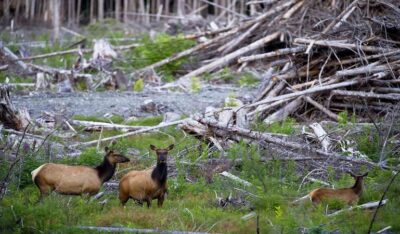At the end of the last great ice age, around 10,000 years ago, 57% of the world’s habitable land was covered by forest. Fast forward to today and forests now cover 31%. An area of forest twice the size of the USA has been lost, and half of that loss has occurred over the last century.
Forests are home to 80% of the earth’s land-based living organisms. Some of our planet’s most iconic species depend on them, including koalas, tigers and elephants – and many, many more. Deforestation has always taken place, both due to natural events and human activity, but it is the pace and scale at which it is happening today that is a problem. Deforestation is inflicting unprecedented changes to the forest habitats on which wildlife depends, and today, around one million animal and plant species are threatened with extinction. One of the main reasons species are going extinct is habitat loss. One of the main causes of habitat loss is deforestation. And the number one cause of deforestation is the meat industry. Read on to find out why.
What Is Deforestation?
Deforestation refers to the destruction of forests – either deliberately, by humans, or by acts of nature, such as wildfires. Deforestation leaves the land barren and depleted. Once the trees are gone, the life forms that live in them go. Most deforestation is taking place in rainforests and jungles – some of the richest ecosystems on Planet Earth – where agribusinesses are chopping and burning vast swathes of pristine forest to make way for grazing cows and growing crops. According to the World Wildlife Fund, 47% of the forests that are left are at risk of deforestation or degradation by 2030.
Why Does Deforestation Happen?
Human activity is now the main driver of global deforestation. Forests are being deliberately destroyed, frequently by a practice called ‘slash and burn’, so that the land can be converted to produce things for people. Whether it’s food, fashion, technology or transport – we want everything bigger, better, newer, faster, and it takes more and more natural resources, and land, to produce it all.
The mining and logging (for timber and paper) industries both contribute to deforestation. Urbanisation (expanding cities), infrastructure (e.g. road-building) and growing populations also play a part. But, the impacts of all of those things pale in comparison to one industry: agriculture. Agriculture – AKA farming – is responsible for 90% of deforestation globally.
It’s not potatoes and tomatoes that are causing forests to be chopped down, nor pineapples, coconuts or bananas. There are three main culprits behind the destruction, and they are meat, soya and palm oil.
In Brazil, an area the size of a football pitch of pristine Amazonian rainforest is destroyed every six seconds to make way for grazing cows and growing soya. The cows become beef and leather. Most of the soya is not destined for the human food chain, it is fed to farmed animals, including pigs, dairy cows and industrially-produced chickens. Global demand for animal products is destroying our planet’s forests and decimating the wild animal populations within. This is not vegan propaganda, it’s the truth.
Meanwhile, global demand for another crop, palm oil, is causing huge swathes of Indonesian rainforest to be converted to monocrop oil palm plantations. An area of Indonesian rainforest the size of the UK was destroyed between 1990-2015. Palm oil is in everything from food to cosmetics to cleaning products. Try as you might, it is hard to avoid.
What Is Habitat Loss?
‘Habitat’ means the natural environment in which wild animals live. A habitat is a healthy ecosystem that provides animals with the food, water, shelter and hunting range they need in order to survive, and thrive. Habitat essentially means ‘home’.
When a habitat is damaged and the animals who live in it lose access to the things that support their survival, this is known as habitat loss – loss of home.
What Is The Main Cause Of Habitat Loss?
The most concentrated deforestation is taking place in tropical rainforests and jungles, which are home to millions of species of insects, reptiles, birds and mammals, some of whom are not found anywhere else. The Amazon is by far the largest land mass of trees, forests, and diverse habitats on the planet. It’s estimated that almost 20% of it has already been destroyed, and with it the lush, vibrant habitats of thousands of species.
How Does Deforestation Lead To Loss Of Habitat?
Deforestation directly causes loss of habitat when forests are cut down, burnt to the ground and cleared with bulldozers. There are also other indirect ways.
Droughts
Climate change and deforestation are interconnected, with each being both the cause, and the effect, of the other. When forests are cut down and the trees killed, they cease to soak up CO2 from the atmosphere. At the same time, they release huge amounts of CO2 and another potent greenhouse gas, methane, into the atmosphere. It is estimated that deforestation contributes to around 10% of global warming. Global warming is exacerbating droughts, making them more frequent, longer and more severe. Animals are driven from their habitat in search of water and may perish from dehydration as water supplies dry out.
Wildfires
Global warming is in turn causing reduced rainfall, drier soil and higher temperatures: the perfect conditions for wildfires to rage. When rainforests, with their cool, humid, fire resistant micro climates, are destroyed, the land and surrounding areas become more fire-prone as tree cover is lost and the earth and ground vegetation dry out. With global temperatures getting hotter each year, wildfires are becoming more extreme, more widespread, more frequent and more destructive, with a higher animal death toll. In 2019-20, unprecedented mega-fires raged across Australia, killing and displacing an estimated 3 billion animals including 60,000 koalas.
Floods
At the same time as causing more droughts and wildfires, climate change is causing more floods. A warmer atmosphere increases the rate at which water evaporates during dry periods. It also holds more water vapour, which fuels heavy rainfall and flash floods. It is almost impossible to quantify how many animals will drown in extreme rainfall and floods. “Weather whiplash”, a drastic swing between extreme drought and unprecedented flooding, is becoming common in some regions, with animals completely unable to cope..
What Are The Main Problems Caused By Habitat Loss?
Once an area has been deforested, without the natural infrastructure animals need in order to survive, the forest can no longer be their home. The animals who survive the slash and burn will be forced to move into unsuitable, unsafe areas and precarious situations that put their survival as individuals, and a species, at risk.
Starvation
Jungle- and rainforest-dwelling animals need to eat the fruits, leaves and berries their forest home provides. Deprived of their food source, they starve. Predators also need large hunting ranges to find and catch their prey. With less wilderness and fewer animals, they, too, face starvation.
Population decline
The inferior, unsuitable habitat that displaced animals are driven into is less able to support large populations. Forced to survive in small, non-viable populations, numbers start to drop. Smaller patches of fragmented territory reduce the opportunity to find mates, causing a loss of genetic diversity.
Increased risk of predation
As animals are driven further from their safety zone into unfamiliar and unsuitable territory, without trees to climb and shrubs to hide in, they become easy prey.
Higher risk of disease
Driven from the free range of their forest homes into more confined areas, less space means more concentrated animals, which makes it much easier for diseases to spread.
Increased interactions with human beings
As animals are pushed out of their natural habitat, they are driven closer to civilisation in the search for food and refuge. This puts them at risk of being hit by a car, or shot if they wander into towns or onto plantations.
Increased risk of hunting
As previously untouched rainforest and jungle gets chopped down, hunters are able to gain access to previously inaccessible parts of the landscape, bringing them closer and closer to vulnerable animals.
How Many Animals And Species Are Affected Or Threatened By Deforestation And Habitat Loss?
According to recent estimates, the world is losing 137 species of plants, animals and insects every day due to deforestation. The International Union for the Conservation of Nature now identifies habitat loss as a main threat to 85% of the species it officially classifies as “Threatened” and “Endangered”.
What Species Of Animals Are Threatened By Deforestation And Habitat Loss?
Some of the world’s most iconic animals are at risk due to deforestation and habitat loss.
In India, the survival of the Bengal tiger is under threat due to deforestation and the impacts of human-caused climate change. Suitable Bengal tiger habitat is on course to disappear within 50 years.
In Australia, the destruction of koala’s eucalyptus tree habitat is increasing, primarily to clear land for grazing cattle. The Australian government has officially declared the koala an endangered species.
The Amazon is home to 427 mammal species, 1,300 bird species, 378 species of reptiles, and more than 400 species of amphibians. Species are still being discovered at the same time as others are being pushed to the brink of extinction. In 2021, a landmark report found 10,000 species of Amazonian plants and animals at high risk of extinction due to deforestation.
4 Amazon Animals At Risk Due To Deforestation:
- Golden Lion Tamarin – endangered; only around 2,500 individuals remain
- South American Tapir – vulnerable/endangered; between 3,500-4000 remain
- Hyacinth Macaw – vulnerable; only about 2,000-6,500 remain
- Jaguar – near threatened
Think about this for a minute. Are we really going to let all of these amazing wild animals – and thousands more – who have a right to exist in freedom and safety in the wild, disappear simply so that people can eat beefburgers? It is astounding to think human beings are letting this happen.
Similarly, in Indonesia, primary rainforest is being destroyed by farming of a different sort. The beautiful, verdant rainforests are being replaced with bare oil palm monocrop plantations. There is no easy solution to the palm oil problem because replacing it with other oils, which have a lower yield per hectare, is likely to accelerate deforestation. (This is a topic for a separate conversation. We don’t have the answers, but we did choose not to use palm oil in our products.)
5 Indonesian Animals On The Edge Of Extinction:
- Sumatran orangutan – critically endangered; around 7,5000 remain
- Sumatran tiger – critically endangered; 5-600 individuals remain
- Sumatran rhino – criticially endangered, fewer than 80 remain
- Javan rhino – critically endangered, only 67 remain
- Pygmy elephant – endangered; approximately 1,500 remain
How Can We Stop Deforestation And Habitat Loss?
Deforestation needs to be tackled on an international, governmental level. You can support this by voting for politicians in your country who will implement planet-protecting laws and regulations. Politicians are not all the same, they have different opinions, different priorities and different beliefs. They can choose to halt or enable destructive practices. We won’t tell you who to vote for, but do not underestimate the power of your vote. Use it, and use it wisely.
5 Things You Can Do To Stop Deforestation And Habitat Loss
- Go Vegan
There is no doubt about it, diet change is the single best thing you can do to reduce your impact on the planet and to help the many species of animals with whom we share it. If you give up meat and dairy, you’ll help to fight climate change, protect the rainforests, save endangered species and reduce the horrendous suffering of farmed animals.
If for whatever reason you can’t go vegan right now, please take whatever steps you can to eat less meat. Beef is the number one driver of deforestation but the intensive production of chickens and pigs is also a huge problem. They are fed soya grown on deforested land in the Amazon, so eating less beef but more chicken is definitely not the answer. (Unless it’s VFC Chick*n, of course.)
- Buy Less
We are consuming more than ever before. We live in a throw-away society and our appetite for shiny new things is seemingly insatiable. And it all comes wrapped in plastic and delivered in cardboard boxes. The production of literally everything, from food to clothing to technology to ‘stuff’, involves inputs (natural resources) and outputs (waste). We need to curb our consumerism if we are going to slow down deforestation and habitat loss caused by mining, logging, pollution and plastic.
- Go Paperless/FSC Certified
The logging industry (cutting down trees for paper and timber) is a big player in deforestation, especially when it is done illegally. If you haven’t done so already, go paperless with your bills and bank statements. If you work in an office where a lot of paper is used, ensure it’s Forest Stewardship Council certified. This guarantees the forest is being managed sustainably.
- Support NGOs
There are many non-governmental organisations (NGOs) working to protect forests, their animal inhabitants and also the indigenous people whose land is being stolen from them to make way for destructive logging, mining and farming. Whether it’s by donating, volunteering or supporting online actions, there are things you can do to help. Get involved.
- Turn Your Garden Into A Habitat
On a micro level, you can help prevent native habitat loss by rewilding your garden and taking steps to make it wildlife-friendly. By giving even a small part of whatever space you have back to Mother Nature, you will start to create an ecosystem. Let some of the wild plants, otherwise known as ‘weeds’, grow, and welcome the bees, butterflies and beetles who feed on them. Providing a small pond could bring you other little creatures, too, such as newts and frogs.
Conclusion
The impact human beings are having on the planet has never been greater, and sadly, it’s not a positive one. Deforestation and habitat loss pose a threat to the survival of countless species. These problems may seem so huge and overwhelming that their solutions feel out of your control, but you can make sustainable choices to reduce your personal impact. Even if you can’t solve everything, you can do something. We urge you to stay hopeful and do what you can.





